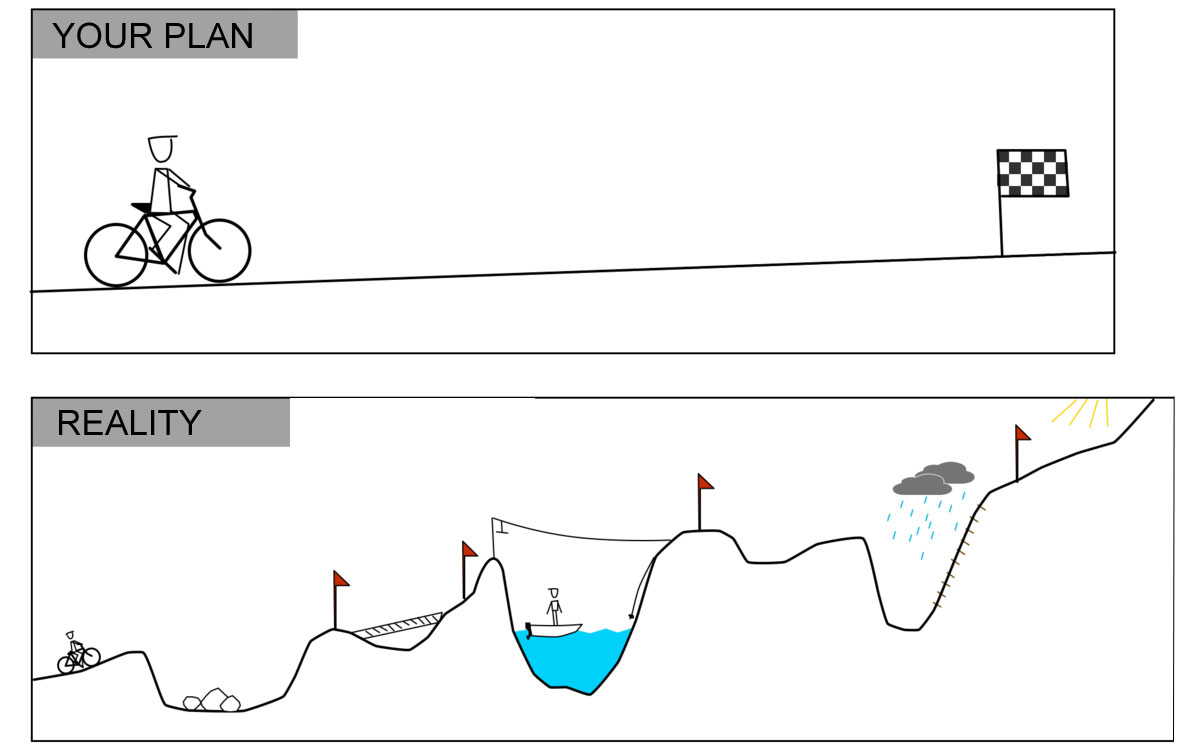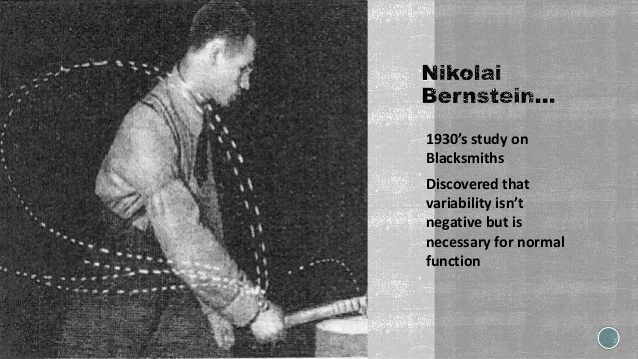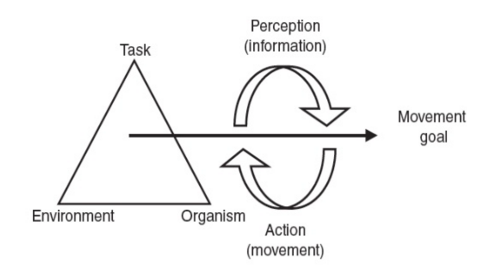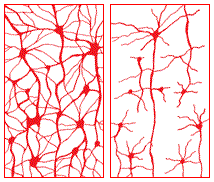Glossary
Nonlinear = The output of a nonlinear system cannot be simply predicted from the input. The function is not a line.
Complex system = a system is complex, when it has emergent properties. This means, the whole is different from the sum of its parts. Living systems and organisms are complex. Complex systems cannot be explained solely by the parts, because the interactions between them are also essential.
Complicated system = A complicated system is difficult to explain or understand, maybe due to the amount of the parts and interactions, but can be explained by researching just the parts. A sophisticated mechanical machine may be a complicated system.
Invasion sport = a sport or game in which the teams try to invade each others territory in order to score points and try to distract the other team from doing so
Co-adaptation = process by which two or more individuals undergo adaptation as a pair or group
Reductionism = The philosophy that a system is understood simply by understanding the parts of it.
Emergence = A system becomes more or different from the plain sum of its parts. A flock of birds or school of fish become stronger than the group of individuals randomly swimming in an area, when they move and act as a flock, swarm or school.
Skill is adaptation to an environment
A floorball player is a living human being and thus a nonlinear, complex system. A team playing floorball against another team is even more complex and nonlinear with a lot of meaningful interactions between the parts. In an invasion sport, the complexity is emphasized because the teams are trying to distract and disrupt the playing of each other – creating a more or less hostile environment. The skill of floorball is about interaction with and being able to adapt to this constantly changing hostile environment – not just as an individual but also as a collective.
Life is not linear, it is organic. We create our lives symbiotically as we explore our talents in relation to the circumstances they helped to create for us.
– Sir Ken Robinson
The learning process in these sports is nonlinear. It is impossible for the coach to control the learning and adaptation of the players by breaking the skill into parts or properties and improving them one at a time. This kind of reductionist training does not directly improve the skill in an invasion sport, because the team or player is not co-adapting or self-organising against anything while training – unless they immerse themselves deeply into some imagined game situation.

Figure 1. Life & reality is not linear
Improving the skill of floorball is about learning to become better at playing the game. That includes the functional technical ability, the psychological skill aspect and also the specific physical fitness of playing well the whole match. The game is not simply about comparing who is faster, stronger or more technical. We cannot assume a direct, linear transfer of training a single property or technique into complex game situations. Playing well is about quality and interaction, not about any set of quantities that may be measured out of context. In this blog text, a new definition for “technique” is explained in order to better understand our sport through this lens of complexity.
The current, mechanistic training paradigm
A large part of the training in floorball today is about improving parts of floorball skill out of context. Properties of individual players are trained one at a time, often one individual at a time. Transfer of speed, endurance, strength or technical model repetitions training into the complex game is taken for granted. Especially during the off-season, a lot of training targets the physical properties of the player isolated from the game environment. Even inside the floorball rink, the chaos and randomness of a real game situation is often erased “to get a lot of clean repetitions”. It is assumed that the game is a complicated system instead of a complex one.
The coaches try to control the training stimuli, maximizing the development of a single property at each session. Each player is assumed to adapt manner to this stimulus in a similar way. Everything is about developing the different properties, parts of the whole. The background for this system lies in soviet sports science of periodization, where the training stress is varied based on physiology only. This kind of reductionism ignores the interactions between the parts of a system. In a real game situation, the properties or structures of a player interact with each other, thus the quantities are not the solution. Something more than the sum of parts emerge from the interactions, just as it happens in a team of players interacting with each other.
What does the science really say about human movement and actions?
The science of motor learning and coordination has shown the previous is not the optimum way to learn motor skill. It is a different skill to be able to adapt to game situations than being able to produce clean techniques on an empty field, unlimited time and space. In a team sport, trainining techniques should be replaced with action and maybe more exactly – interaction. Optimal model techniques do not exist in the context of this kind of team sport.
Actually even a very closed skill such as rifle shooting or hitting a coin or a target with a hammer is not about repeating an identical motor pattern over and over. It was proven in a classic study by Nikolai Bernstein who is one of the pioneers in of motor learning and coordination sciences already in the 30’s. This does not mean that all drills or individual technique training are bad for the players. There is also variability in a drill, just less than when playing against opponents. Training drills transfers in a different way than the coaches think and are not the optimal method in a team training when you have opponents available. Movement is always about adapting to a situation. There’s always variability in the movement pattern even in closed skill events. Even more so in an invasion sport.
It is generally assumed that doing a lot of isolated repetitions would bring more order and stability to the performance of an individual. But it is the end result we want to stabilize, not the technique used. Variability is fundamental for adapting to changing situations. In invasion sports this is highlighted, but a living human is always in the process of change. Every situation we are in, is different. The repetition of any action is never exactly the same. We must be very adaptable to produce stable outcomes. This principle is called repetition without repetition. To understand human motor learning is essential in order to truly understand team sport skills and coaching.

Figure 2. Even for professional blacksmiths with years of training, there are no similar repetitions or a single technique to hit the coin. The blacksmiths that were less accurate, had more constant movement pattern and the more accurate hammer users showed more variability in their motor patterns.
The human, the brain and the motor system are adaptable and creative. They will try to find a solution that is adapted to any new problem on hand. The brain does not store complete movement techniques or other prefabricated solutions. It adapts. Memory works the same way – it is a process and it needs a context:
For multiple reasons, the over-analytical way of training and testing isolated properties are currently the dominant fashion. Reductionist way of thinking has given the humanity a lot of improvement and innovations in science, especially in the industrial domain. However, new and more holistic thinking is soon needed if we want to solve the current ecological and social problems. The status of scientific method as pure truth and especially reductionist science are challenged and questioned even outside of the sporting world. The subjective perceptions, social and environmental values must be acknowledged and appreciated. The complexity paradigm is gaining ground on different domains.
Short introduction to Nonlinear pedagogy & the Constraints Led Approach
Human beings in a complex game demand a nonlinear framework for coaching and training. Such frameworks are nonlinear pedagogy and constraints led approach (constraints based learning). In the constraints led approach and nonlinear pedagogy, the performance emerges as the interaction of three constraints: the task (objective), the environment and the organism. The organismic constraints mean the properties of the organism that limit which solutions are possible for the organism (an individual or a team).
The learner/performer exists in an environment, where he/she searches and finds solutions for the situation to complete the given task. Within these constraints, solutions can emerge creatively in the situation. This is also called self-organization. The learner has the freedom to develop any individual technical-physical solution that produces the desired outcome inside the constraints.

Figure 3. The image represents the basic theory of constraints based learning: the organism is put in an environment with a task to achieve. These three constraints create a “triangle” of constraints. Performance or movement emerges from these constraints as the organism perceives and acts according to the situation that is updated also during the action itself.
Skill is about perception-action
There is no perception and action, only perception-action and this happen “online” as a continuous cycle. It is constant adaptation to the situation and could be understood by “being in the present” or a kind of mindful playing. It is not a sequence of perception, analysis, decision and execution. The performer adapts into the situation “online”, solving the given motor problem by adjusting the movements in real time while executing the action. In a pressure situation, there is no time for analysis and decision making. Large part of the perception-action happens subconsciously. A movement pattern cannot be selected from any "library" and ran through after the decision is made.
Skillfully dodging the opponents while dribbling through a gap in defence into an open space is an example of perception-action. In such cases the player cannot just “run” a pre-planned movement pattern that he/she goes through, but must be present in the moment and adapt to the opponents actions. This cannot be learned in isolation – but only playing against opponents. It is the skill of percepting-acting in the specific sporting environment and real game situations.
Video: Perception-Action in a floorball match. You cannot just execute techniques, you need to perceive the environment around you and adapt to it with technical skill structure. This is about interaction and cannot be learnt by dribbling cones.
So to play better – you need to play. Training should not fragment the game into separate technical or physical components. The coach does not need to know which properties of the player are developed during the current session. Instead, he helps to create a learning environment and lets the players find and improve their solutions individually. The players get opportunities to adapt in a game environment. Some find the solutions more based on physicality, some technical skill and some by using tactical intelligence and for example deceiving the opponents. Instead of every player performing the same techniques, the actions may vary. Everyone has the opportunity to develop and use his or her own strengths.
We have to recognize that human flourishing is not a mechanical process; it's an organic process. And you cannot predict the outcome of human development. All you can do, like a farmer, is create the conditions under which they will begin to flourish.”
― Ken Robinson
Redefinition of technique
In a sport such as floorball is, the outcome of an action is what matters – points are not awarded for using model techniques. The actual technique is of no interest if it yields the desired tactical outcome. It doesn’t matter how you shoot the ball if it ends up in the opposing goal, or how you pass if the teammate receives the pass into a good position and situation.
Technique in floorball and other team sports is to be understood as the functional ability to adapt to the situations and generate action. This demands training the perception-action of the players in the game and team context. The ability to produce any number of out-of-context clean model techniques is not the same thing. Technique in floorball is a qualitative structure of technical ability rather than a quantitative amount of individual technique.

Figure 4 On the left, a person has a dense structure of connections in the brain and may adapt to specific situations with multiple solutions. On the right instead, only a few routes are available. In a video lecture, Sami Kalaja is speaking about a similar situation in controlling the calf muscles and comparing a figure skater and an endurance runner. Both have trained a lot, but the former with much greater variability.
Everybody agrees that technique is important in floorball, but if our concept of technique means the skill on an empty field, it simply does not represent the game. We need to examine what is important in order to effectively solve sport-specific motor problems in a game environment. Defining technical skill as a qualitative structure instead of quantitative amount recognizes the true nature of the sport performance. It is adaptability that should be coached instead of any number of model techniques. The players should be given the freedom to creatively use their individual talents and find their own solutions and strengths. Training may be supplemented with individual training on the players free time, but in a team session it is a waste of resources to train technique in isolation. We have limited time to gather the team together and coach perception-action in real game situations. The team and groups inside it need to train co-adaptation as a collective (a topic for a new blog). These skills of co-adaptation and perception-action are essential for the players to become skillful instead of just technical.
Someone who has juggled the ball in the air during a game, after which four defenders of the opponent get the time to run back, that’s the player people think is great. I say he has to go to a circus.
Technique is not being able to juggle a ball 1000 times. Anyone can do that by practicing. Then you can work in the circus. Technique is passing the ball with one touch, with the right speed, at the right foot of your team mate.
– Johan Cruyff
There are a lot of good texts available on the internet on these topics. Here’s a couple of links into suggested reading:
https://www.academia.edu/1424186/What_Exactly_is_Acquired_During_Skill_Acquisition?auto=download
https://footblogball.wordpress.com/category/constraints-led-appraoch/
https://aeon.co/essays/your-brain-does-not-process-information-and-it-is-not-a-computer
https://qz.com/866352/scientists-say-your-mind-isnt-confined-to-your-brain-or-even-your-body/
https://harrimannonen.com/2016/07/02/complexity-creativity-and-everything/
“Over thinking, over analyzing, separates the body from the mind
Withering my intuition, leaving opportunities behind” – TOOL
Antti Hänninen (@AjHanninen)
